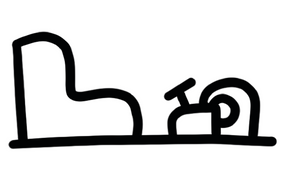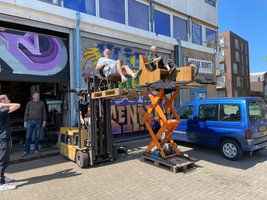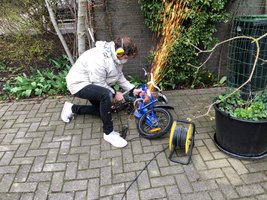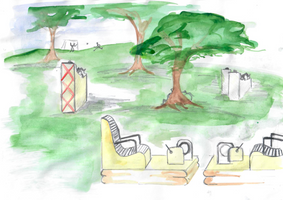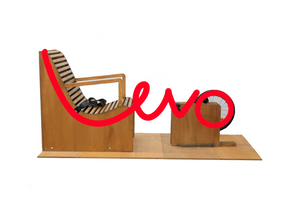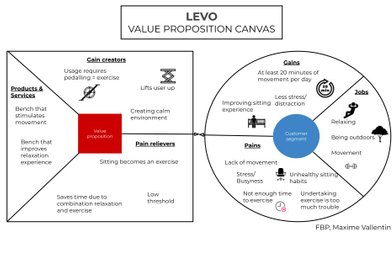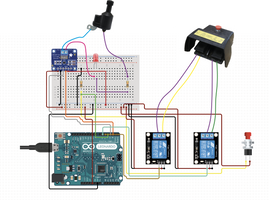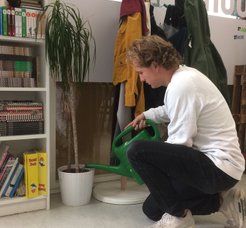PRESENT
USER & SOCIETY
Concerning this area, I have undertaken several small but essential steps, using different methodologies with different objectives. I did an observation in public, then researched the problem using literature, observed again and started user testing when I had a prototype. From this, I have learned that this method of user-centred designing, i.e. consisting of multiple methods with specific and narrow goals, that follow each other up quickly, creates a smooth process for me. This is the case because I value getting multiple insights on the user and society of my design and immediately implementing these.
Unfortunately, I made a mistake during one of my user tests which caused the results to be ethically inappropriate. From this, I have learnt the great importance of carefully following the relevant Ethical Review Forms. Moreover, it strengthened my awareness of constantly focussing on ethical issues during the process, especially when I am excited about something and might derail. I will from now on always have my user testing ideas checked by superiors or the proper committees.
TECHNOLOGY & REALIZATION
With regard to the realization of the design concept, I have developed myself greatly during my Final Bachelor Project. I had to buy a very expensive and unmanageable lift and arrange all sorts of material and space. At first, I was somewhat hesitant but eventually I had to make decisions. Fortunately, everything worked out properly and I now feel more confident about arranging and realizing such a big product.
I’ve learned or improved a great variety of new skills. Since I had to work with metal and the hydraulic system, I developed my ability to weld and my understanding of such a system. Moreover, I have built a piece of furniture for the first time. This taught me how to be aware of all different aspects of furniture; e.g. comfortable materials, leaning angles and the size.
Moreover, I developed my coding skills. I am now able to program a state machine. Moreover, I strengthened my understanding of coding a full program since I had to do this completely on my own for the first time.
CREATIVITY & AESTHETICS
The aesthetics of my project were very relevant since one of the main preconditions for a bench to be a success is pleasing aesthetics. I think one great aspect of LEVO is the fact that it was designed based on the actual shape of the word, which adds a layer to the product. This strengthens the narrative of LEVO. However, I believe the aesthetic aspect of LEVO could be developed and elaborated somewhat further.
In the ideation phase, I used a sketching challenge, i.e. creating 50 sketches, to come up with solutions. I was pleased with this method since I think very visually and could constantly go back to previous sketches and get inspired to create more. Moreover, I used observation in the public to identify problems and generate solutions. After roughly having conceived a concept, I did an Intellectual Property research and benchmark to figure out what kind of similar designs already existed.
When designing the report, I practiced with graphic design, using Adobe Illustrator. The variety of information sorts and the size of the report made this quite challenging for me. However, after some time of perseverance, I learned how to create a proper whole of the report.
BUSINESS & ENTREPRENEURSHIP
For this competence area, I created a base by filling in a SWOT analysis, a Value Proposition and a Business Model Canvas. These two tools gave me valuable insights, both on the opportunities for LEVO and on the structure around it. For me, it was useful to identify possible risks in an early stage, using the SWOT analysis and a Design Risk Assessment. This way, I could start thinking about solutions during the further realization of the concept. Moreover, based on the market analysis and benchmark I could identify weaknesses in existing similar products. I feel like using these six tools, which all present different takes and insights on business, properly completed the theoretical analysis around LEVO. After this, I was ready to take on the practice side of business, which was quite difficult to do to my full potential due to the COVID-19 regulations. Normally, I try to have as much face-to-face contact with stakeholders as possible. The importance of this was once again stressed during this process. I could not reach as many people as I wanted to through digital contact, probably because they were preoccupied with the COVID-19 regulations. As soon people actually observed and experienced LEVO themselves, they became quite interested and fascinated by the concept. For example, during one of my user tests someone who worked at NEMO, a science museum in Amsterdam, showed great interest in my product. From this, I experienced and learned that, even though it might be more difficult in some cases, it is most of the time more effective to reach people face-to-face and give them the full experience. The least effective way is to send an email to a general mail account because you most likely will hit a wall of employees and bureaucracy.
MATH, DATA & COMPUTING
Concerning data collection and analysis, I performed quantitative and qualitative research. The results and the drawn conclusions provided me with insights which I implemented in my design.
Moreover, I installed the dynamo in such a way that it was connected to the system of the scissor lift. For this, I needed to make computations on the electrical system. The experience of coming up with the right method to do this has been valuable for my development in this area since it made me aware of the possibilities and weaknesses of such a system.
PROFESSIONAL SKILLS
The process of my FBP was valuable for the development of my professional skills on different levels. Because I had to do everything on my own, and this was the first design project for which I had to use all the theoretical knowledge, methods and tools, I sometimes had difficulty planning. Even though I did have an idea of what I wanted to do and a planning at all times, at certain instances I would be absorbed by a certain aspect. I had to remind myself in those cases that I had more things to do and that it is essential to divide your time properly.
Moreover, since I had to write such a large quantity of scientific text, this strengthened this skill. After the midterm, I rightfully got feedback that I should sometimes write more to the point and differentiate better between main information and side issues. In the final report, I was more strict with myself and practiced killing my darlings. This will be valuable in the future, e.g. in communication with potential clients.
OVERALL GROWTH
I feel like I have gained the most relevant insights concerning my professional identity and vision. By thinking about and tweaking my PI&V during every stage of the process, I have discovered my true characteristics and wishes for design. I feel like this has given me a great base for the future since I now understand better who I am, both as a designer and as a person, and what I want to do. Because of this project and process, I feel like a proper designer who is ready for the future.
